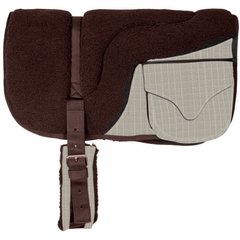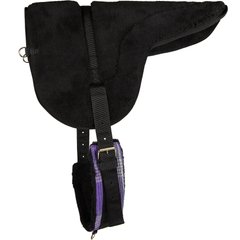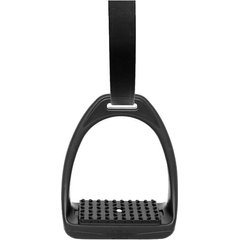Bareback Horse Riding: Is It Safe and Should You Try It?

Photo by Tatsiana Hancharova/iStock/Getty Images Plus
Bareback riding, or riding a horse without a saddle, is not only a lot of fun, but it can also deepen your bond with your horse while improving your riding skills. But like any other activity with horses, bareback horseback riding has some risks.
From choosing the right horse to picking the right time and setting for your ride, there are many ways that you can maximize your safety and enjoy your first bareback ride.
Key Takeaways
- Bareback riding offers many benefits, including improved balance, strength, and awareness of your horse’s movement.
- While riding bareback is great for many riders, it’s important to have basic core strength and an independent seat before trying it.
- When learning to ride bareback, choose a calm and quiet horse who’s familiar with bareback riding.
- A bareback pad can help make your ride more comfortable for both you and your horse.
What Is Bareback Riding?
Bareback riding refers to riding a horse without a saddle. Some riders choose to use a bareback pad for comfort and a bit of extra security, but that is just personal preference.
Riding bareback is an ancient art; in ancient Rome, riders rode bareback before saddles were invented. Many Native American tribes rode bareback, too, and bareback bronc riding is a rodeo event that evolved from cowboys who tamed horses without using saddles.
Many riders still enjoy bareback horse riding for several reasons. It’s an enjoyable leisure activity that can also be a valuable training tool. Some horse shows or timed competitions, known as gymkhanas, also incorporate bareback classes.
Benefits of Bareback Riding
Bareback riding offers numerous benefits to both horse and rider.
Riding a horse bareback can help a rider feel more connected to the horse, explains Linda Leiden, an instructor at Greystone Manor Therapeutic Riding Center in Lancaster, Pennsylvania.
“While bareback, the rider can more clearly feel the three-dimensional, rhythmic, repeatable movement of the horse,” she says. “With no stirrups to brace or stabilize against, the rider learns to appropriately engage their core muscles to follow the equine movement, maintaining balance and stability in forward motion and turns.”
Leiden explains that most bareback riders naturally seek a centered seat, which can improve their balance, comfort, and confidence.
When bareback riding is done properly, it can support improved biomechanics and communication between horse and rider, says Brooke Drassal-Creighton, an equine bodyworker and certified equine rehabilitation practitioner at Brooke Drassal Equine Bodywork in Long Lake, Minnesota.
“As an equine bodyworker, I love when riders explore bareback riding,” she says. “It enhances awareness of both the horse’s and rider’s body, encourages proper engagement through the core, and helps identify patterns that may be missed under tack.”
Risks and Safety Concerns of Riding Bareback
While bareback riding offers many benefits, there are also certain risks, and it’s important to be aware of these safety concerns:
- Increased risk of falling, because a rider lacks the support of stirrups and a saddle
- Potential injury to the rider, including bruising, muscle strains, or broken bones from a fall
- Discomfort for the rider and horse, especially if a horse has a prominent backbone or underdeveloped topline
- Increased fatigue for the rider, which can result in weakened strength and an increased chance of falling
Who Should—and Shouldn’t—Ride a Horse Bareback?
Both beginner and advanced students can benefit from riding bareback, but it’s important to have the right foundation.
Bareback riding requires a rider to move with the horse’s motion rather than against it, says Drassal-Creighton. “A rider should have an independent seat, soft hands, and the ability to use their core—not just their legs—to stay centered,” she says. It’s also ideal if the rider can post the trot without stirrups and without relying on the reins for balance.
Leiden explains that certain physical issues may limit bareback riding, such as:
- Balance issues
- Increased fragility
- Arthritis or lack of muscle tone, which can limit range of motion, particularly through the hips
- Behavioral limitations that make it difficult for riders to sit quietly without balancing or rocking
It’s also important to consider the horse’s suitability for bareback riding. Horses with prominent spines, underdeveloped back muscles, or issues like kissing spine or swayback may be uncomfortable for a bareback rider.
“If your horse has shown signs of saddle-related issues, like lameness or tail swishing, or tension through the back, consult your veterinarian and equine bodyworker before attempting bareback work,” Drassal-Creighton recommends. “The horse’s comfort and health come first and bareback riding should never add to their discomfort.”
Tips for Riding a Horse Bareback
- Choose a quiet location. Drassal-Creighton recommends that riders start in a safe, quiet arena and ideally have someone nearby while they ride.
- Use a bareback pad. A bareback pad provides extra cushion and can help keep you and your horse comfortable. Leiden cautions against attaching stirrups to a bareback pad because they can put the rider into a chair seat, and imbalanced pressure on one stirrup will cause the pad to slip sideways.
Recommended Products
3. Choose a calm horse. When you first start riding bareback, choose a calm, experienced horse.
4. Wear safety gear. A well-fitting riding helmet and boots, such as paddock boots, are essential to maximizing your safety during every ride, including during bareback horseback riding.
Recommended Products
5. Consider using a leader and side-walkers. Leiden explains that a leader and side-walkers (two people walking alongside either side of the rider for support) can help maximize rider safety when you’re first getting started with bareback riding.
6. Focus on posture and balance. Drassal-Creighton recommends riders focus on their breathing, which can help them stay relaxed and centered. “Allow your hips to follow your horse’s movement, and keep your legs long to avoid gripping,” she says.
7. Pay attention to your horse’s body language. “Ears pinned back, a swishing tail (that isn’t from flies), or frequent glances at you may signal discomfort,” says Drassal-Creighton.
Alternatives To True Bareback Riding
There are several alternatives to true bareback riding that can help maximize comfort and security, like bareback pads, which provide extra cushioning for you and your horse.
“Coming from the therapeutic riding world, I have found riding in a bareback pad very beneficial for a variety of riders,” Leiden says. “It teaches a natural, following seat, confidence, development of core strength and stability, and the opportunity to try riding sideways or backwards for a fun challenge.”
If you’re working on improving your balance and staying centered in the saddle, try riding without stirrups. Learning to post without stirrups can develop your strength and balance, too.
Recommended Product
If approached wisely, bareback riding can be rewarding and safe for you and your horse. It can improve your balance and strength; plus, it can be a great way to gain awareness of your horse’s movement and build your bond with your horse.








